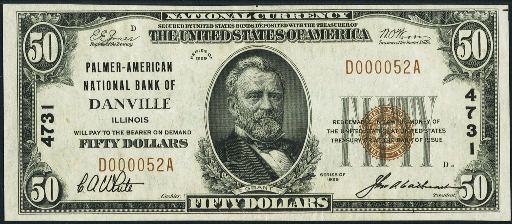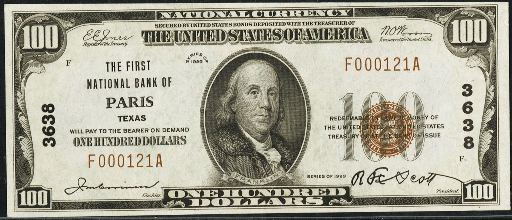The Butler County National Bank Of Butler
The Butler County National Bank Of Butler in Pennsylvania printed $3,912,750 dollars worth of national currency. Over $1,000,000 face value is a lot of money. However, some types and denominations of currency from this bank could still be rare. This national bank opened in 1890 and stopped printing money in 1935, which equals a 46 year printing period. That is a fairly normal lifespan for a national bank. During its life, The Butler County National Bank Of Butler issued 8 different types and denominations of national currency. We have examples of the types listed below. Your bank note should look similar. Just the bank name will be different. For the record, The Butler County National Bank Of Butler was located in Butler County. It was assigned charter number 4374.
We buy all national currency. Please call or email us for a quote. Sales@AntiqueMoney.com
The Butler County National Bank Of Butler in Pennsylvania issued 16,150 sheets of $10 1882 brown back national bank notes. When we start talking about a printing number in the five figure range, then you are likely not dealing with a great rarity. However, the note could certainly still be popular and valuable. There were three $10 bills printed on a single sheet of 1882 brown backs. The design of the bill is similar to all earlier ten dollar national bank notes. The nickname comes from the fact that these bills have a brown seal and brown overprint. Despite saying series of 1882, these were actually printed by some banks up until 1908. The date you see in cursive relates to when the bank first started issuing brown back notes.
Series of 1882 $10 Brown Back
The Butler County National Bank Of Butler printed 16,150 sheets of $20 1882 brown back national bank notes. Due to the way brown back sheets were printed we know that the sheet output number equals the number of $20 brown backs printed. When we see a number over 10,000 there is a good chance that the note isn’t going to be especially rare. However, it never hurts to ask. One neat thing about all brown backs is that they each have a different back design based on which state issued them. The back left hand side of the note shows the state seal of which ever state the national bank was located in. Generally speaking, 1882 $20 brown backs are pretty difficult to locate. They typically were printed in small numbers and they don’t have a great survival rate.
Series of 1882 $20 Brown Back
The Butler County National Bank Of Butler also printed 4,599 sheets of $10 1882 blue seal national bank notes. That is a pretty standard sheet output number for these issues. Most of the value is going to be in the condition. All of these notes say series of 1882 but they were actually printed between 1908 and 1921. So they aren’t quite as old as the dates might suggest. There is also a date on these notes that is between 1888 and 1901. That date is written in cursive text and it represents when the bank was chartered or re-chartered. Some of the so called 1882 value back notes have a chance to be really rare. Most of the earlier notes that say 1882-1908 on the back are likely going to be relatively common. The designs are exactly the same on the front. Each has a blue seal and charter number.
1882 Blue Seal $10 National Bank Note
The Butler County National Bank Of Butler also printed 4,599 sheets of $20 1882 blue seal national bank notes. That is the same number of sheets as the ten dollar denomination. You don’t have to multiply by three to get the exact number of notes issued though. There was only one twenty dollar bill per sheet. As with any national bank note, the exact value is still based on the condition, serial number, and bank of issue.
1882 Blue Seal $20 National Bank Note
The Butler County National Bank Of Butler also printed 7,156 sheets of $50 1902 blue seal national bank notes. There is no trick to knowing which 1902 blue seals will be common and rare. Often times the number printed won’t tell you much information. The value still comes down to condition and demand. That is a surprise to most people. In fact, most 1902 $50 bills we see are worth between $750 and $1,250. The rarer ones can be worth more than $5,000. However, there isn’t much middle ground.
1902 $50 Blue Seal National Bank Note
The Butler County National Bank Of Butler also printed 7,156 sheets of $100 1902 blue seal national bank notes. It is no coincidence that the sheet numbers for $50 bills and $100 bills are the same. They were printed on the same sheets. Most $100 blue seals are at least scarce; others can be very rare. John J Knox is printed on the front of each bill. Most collectors like the back design a lot more though. It is really unique and different from most other national bank notes. Prices for 1902 $100 blue seals are pretty similar to $50 blue seals. They are both equally common or equally rare, depending on how you look at it.
1902 $100 Blue Seal National Bank Note
The Butler County National Bank Of Butler also printed 716 sheets of Type1 1929 $50 national bank notes. This is a small print range, but it does not guarantee rarity. As is the case with all modern fifty dollar bills, Ulysses Grant is pictured on the front of 1929 $50 bills. This is a higher denomination that was only printed by 300 different national banks. Many examples are only worth around a few hundred dollars. Rarer specimens can sell for more than $1,000.
Series of 1929 Type1 $50 National Bank Note
The Butler County National Bank Of Butler also printed 240 sheets of Type1 1929 $100 national bank notes. That may sound like a very small number, and it is. However, when it comes to small size notes, that print range usually allows for a handful of survivors. Despite saying series of 1929, all type1 national bank notes were actually printed between 1929 and 1933. Exactly 289 national banks printed $100 type1 notes. Most are relatively common. However, as with anything, there are always exceptions to that rule.
Series of 1929 Type1 $100 National Bank Note



